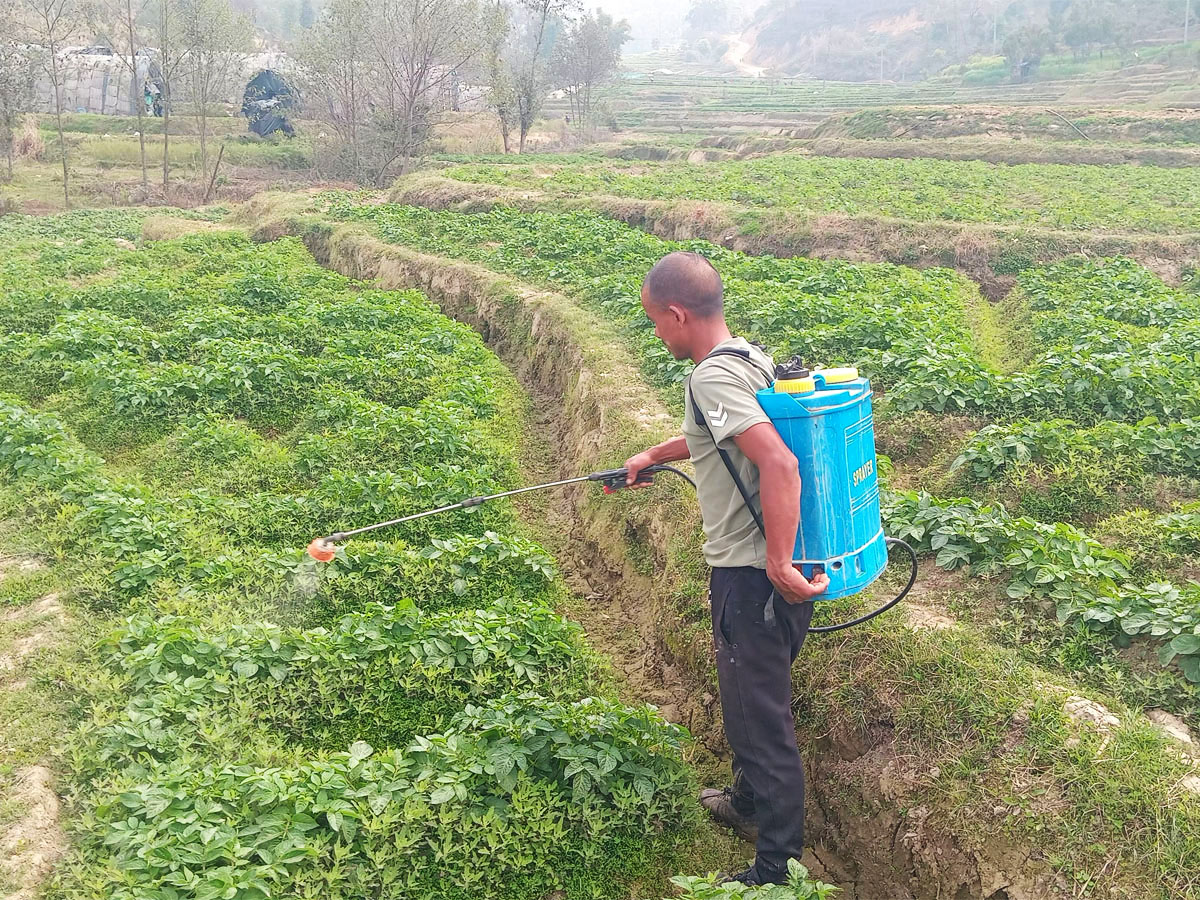Editor's Note: This story was first published in Nepali, read it here: नुनमा झेल : उत्पादनमा हुनुपर्ने आयोडिनको मात्रा भान्सामा, रोगको जोखिम. Following the publication of this investigation, the Nepal government has decided to implement the 1998 Act (2055 BS) to regulate iodized salt, effective from July 17, 2025.
Aashma KC ventured from Gwarko, Lalitpur, into Asan, Kathmandu, in search of salt. She certainly didn't travel the 8 kilometers to the alleys of Asan just because she couldn't find salt at the shop near her home. Searching through many shops for rock salt lumps, called dhike nun in Nepali households, she reached Asan for the first time to buy it.
 Upon inquiring, she discovered that the salt was available in the first alley on the right as she proceeded from Asan towards Indrachowk. There, 70-year-old Subarna Shrestha sat leaning against the wall, with rock salt stored in a wooden container.
Upon inquiring, she discovered that the salt was available in the first alley on the right as she proceeded from Asan towards Indrachowk. There, 70-year-old Subarna Shrestha sat leaning against the wall, with rock salt stored in a wooden container.
She explained that her family had been trading salt for over a century, and she was waiting for customers like Aashma, who preferred to use rocksalt.
Aashma, accompanied by a friend, requested Subarna to pack three kilograms of salt. Here, salt isn't measured by weight, but rather filled into paint tins. Subarna claims that one tin holds two kilograms. Subarna's salt shop is located at the beginning of an open space surrounded by houses, which also serves as a parking area. Aashma has now been added to the list of regular customers at this shop.
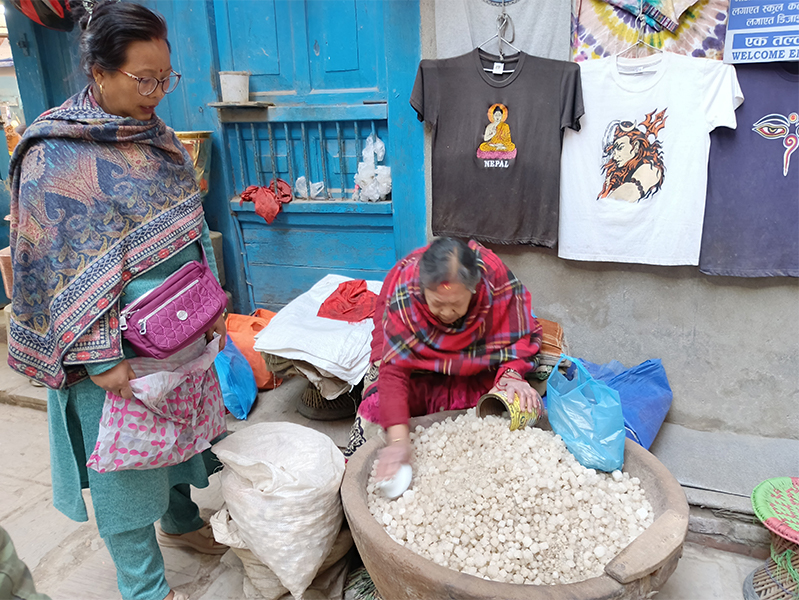
Aashma's family agreed to bring rock salt into their kitchen after hearing that packaged salt contains excessive iodine. She says, "I've heard that packaged salt available in Nepal has too much iodine. That's why we decided to make a change in our kitchen and started using rock salt."
To control goiter, the government set the iodine level in salt in 2000/2001 AD. According to that, salt should have 30 PPM (parts per million) of iodine when it reaches the consumer's kitchen. This level is not only what the World Health Organization (WHO) has set, but is also more than double the standard set by neighboring India.
However, in the kitchens of Nepalis, whom the government itself is feeding excessive iodine, the iodine level is reaching double the government-set minimum and three times the WHO standard. As a result, we are suffering from diseases caused by excessive iodine.
The World Health Organization (WHO) has set a standard of 40 PPM at the production level and 15 PPM when it reaches consumers. Neighboring India has a standard of 15 PPM when consumers purchase in retail shops and 30 PPM during production. Nepal's standard has significantly more iodine than both the WHO and Indian standards.
According to the government-set standard, salt sold in Nepal should have 30 PPM iodine when it reaches consumers. However, when the Nepal Investigative Multimedia Journalism Network (NIMJN) tested samples of iodized salt packets collected from all seven provinces and rock salt being sold in Asan, they found much more iodine content than allowed by the government-set level.
Specifically, nine iodized salt samples and one lump salt sample were tested at the government's Food Technology and Quality Control Department, and two iodized salt samples were tested at an established private sector lab. The results showed 246 percent more iodine content in them than allowed by the WHO and Indian standards.
The iodine content in salt has been found to be nearly double the level set by the government in 2000/2001. Testing of 10 samples at the Department revealed that iodized salt with iodine levels ranging from a minimum of 30 PPM to a maximum of 52.2 PPM is being sold in the market.
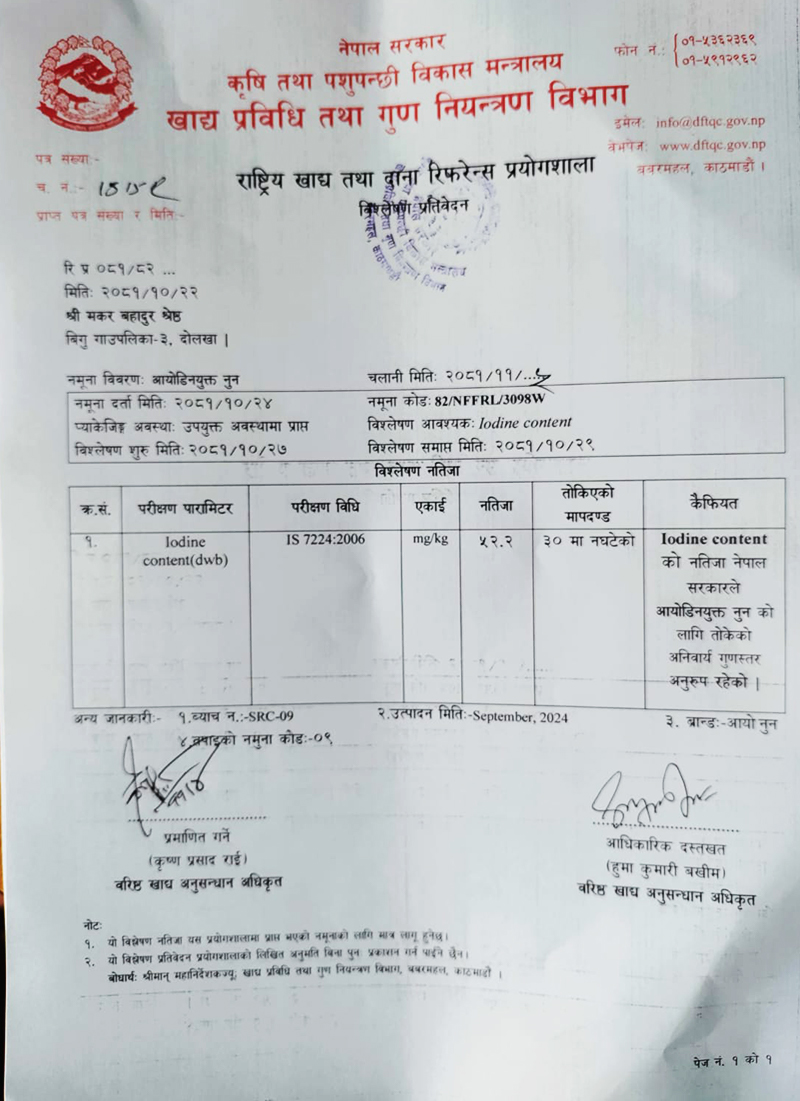
The report provided by the Department states, "The prescribed standard of 30 has not decreased. It is in accordance with the mandatory quality standard set by the government for iodized salt." While the government has set a minimum iodine level of 30 PPM, it has not specified a maximum limit.
Of the 10 samples tested at the Department, 7 showed iodine levels between 30 and 40 PPM, and 2 showed levels above 40 PPM. In contrast, the two tests conducted at Jestha Lab found iodine levels of 49.3 and 48.52 PPM.
The Department itself collected samples last year and found even higher iodine levels, reaching up to 80 PPM, when testing salt. Last year, out of 19 samples tested, the Director General of the Department, Sanjeev Kumar Karna, stated that the iodine content ranged from a minimum of 51 PPM to a maximum of 80 PPM.
Of the 19 samples tested by the Department, 12 showed iodine levels between 50 and 60 PPM, 5 showed levels between 61 and 70 PPM, and 2 showed levels between 71 and 80 PPM. The samples with 80 PPM contain iodine 433 percent higher than the standard set by the World Health Organization.
According to the results of the samples collected and tested by NIMJN, 8 out of 10 samples were found to have iodine levels between 30 and 40 PPM, while 2 samples showed levels above 40 PPM. "Whatever results came from the testing, it is within the standard set by the government," said Sanjeev Kumar Karna, Director General of the Department.
Like Aashma, Susmita Thapa, who came from Dakshinkali, Kathmandu, is also among the crowd regularly buying rock salt in Asan due to fears that iodized salt has too much iodine and can cause illness. She stated that she uses rock salt because there are thyroid, sugar, and heart patients in her home. "Doctors advised us to use rock salt one day and iodized salt the next, so we have been eating rock salt for a year," she said.
Dr. Ansumali Joshi, an endocrinologist at Kathmandu Diabetes and Thyroid Center, stated that he advises individuals with thyroid issues to consume rock salt for one meal and iodized salt for another due to the high iodine content. "The number of people with thyroid problems appears to be increasing because of the high iodine content in salt," he said. "After discovering that thyroid problems are caused by iodine, I advise them to eat iodized salt for one meal and rock salt for another to balance their iodine intake."
According to him, consuming iodized salt for just one meal provides the body with the right amount of iodine. "Until the government reduces the iodine content, there is no alternative but to do this," he says.
As doctors themselves have started suggesting consuming less iodine, not only urban consumers but also rural consumers have gradually shifted towards rock salt, abandoning packaged iodized salt.
The trade of Deepak Pandey, a merchant from Singati, Dolakha, indicates the increased demand for rock salt. He says, "When I bring down 35 sacks of rock salt (1,750 kg), I only bring 10 sacks of iodized salt." He explains that in villages, people, not just livestock, have started using rock salt.
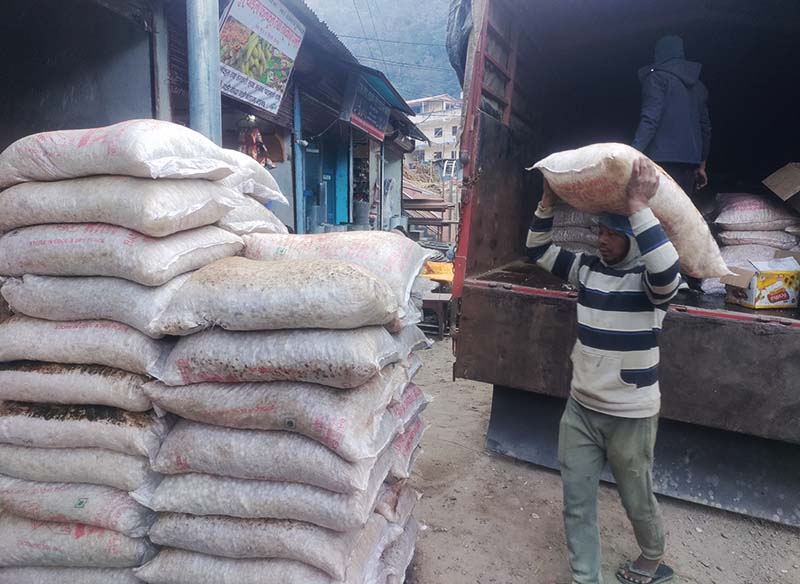
On January 23, 2001, the then Ministry of Agriculture and Cooperatives, using the authority granted by Section 7 of the Food Act, determined the iodine content that should be present in salt. According to the notice published in the Gazette, the iodine content should be 50 milligrams per kilogram (50 PPM) at the production level and 30 milligrams per kilogram (30 PPM) when sold at retail.
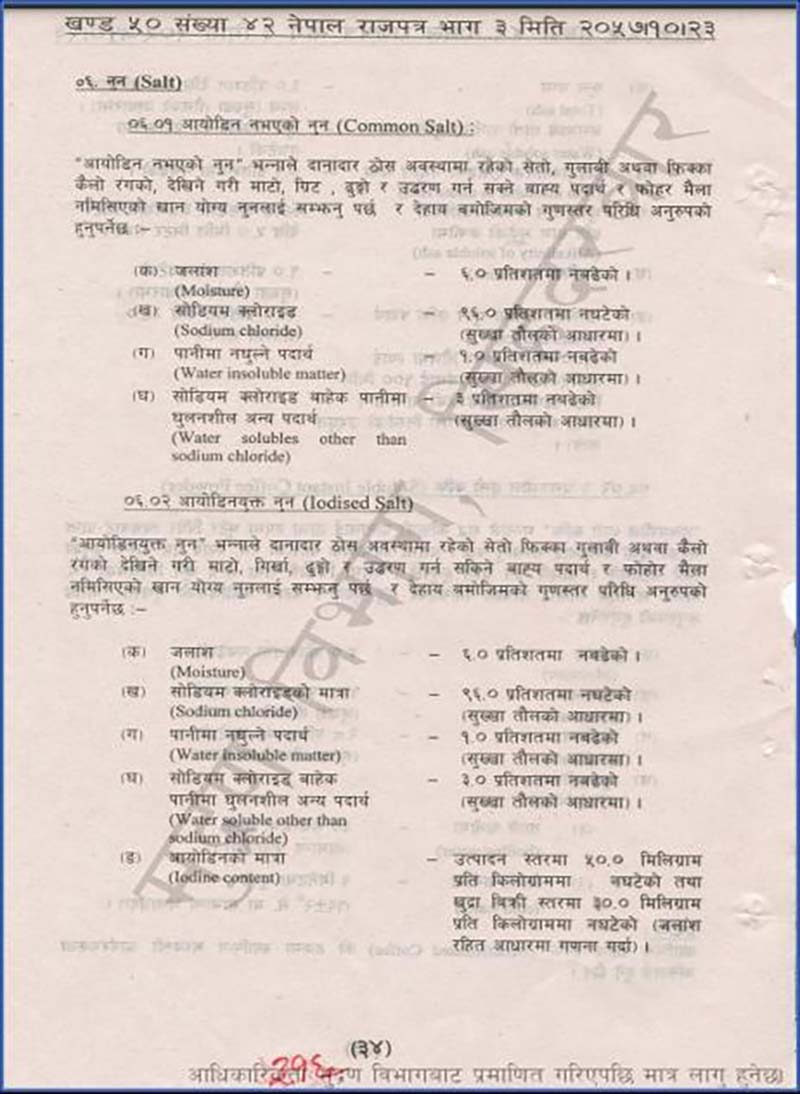
"This level was set to prevent goiter, which is caused by iodine deficiency," said Dr. Bibek Kumar Lal, Chief of the Family Welfare Division of the Department of Health Services. "Currently, there is no goiter problem, but the iodine content standard remains the same."
Iodine in rock salt too
Although consumers seeking to consume less iodine are scouring the alleys of Asan for rock salt, and despite the high demand for rock salt instead of iodized salt in villages, rock salt is also not iodine-free.
Of the 10 samples tested by NIMJN, one sample was rock salt. We had purchased that salt openly from Asan and submitted it for testing.
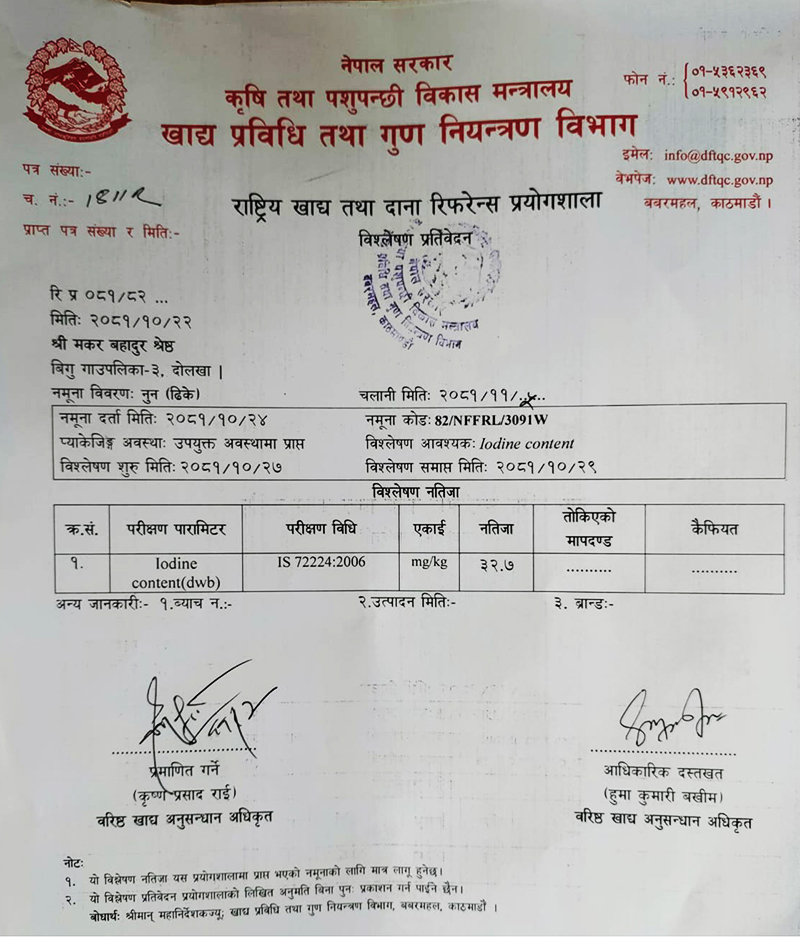
It is said that iodine evaporates when exposed to open air, which is why the standard is set at 50 PPM during production and 30 PPM when it reaches the kitchen. However, we found 32.7 PPM of iodine in the rock salt we purchased openly.
Similarly, a salt sample collected from Biratnagar, packaged in January 2025, showed 33.6 PPM of iodine.
We collected another packet from Surkhet, which was packaged by India's Ankur Chemfood Limited in January 2024, exactly one year before the Biratnagar sample was packaged. This sample showed 35.7 PPM of iodine.
Different laboratories, different results
NIMJN sent one packet of the same batch of samples that was tested at the Food Technology and Quality Control Department to a private laboratory.
A packet with batch number KTM/ZET A/two, packaged in Kathmandu in January 2025, showed 41.5 PPM of iodine when tested at the Department. The same batch, purchased from the same shop, showed 49.3 PPM of iodine when tested at Jestha Lab in Bhaktapur.
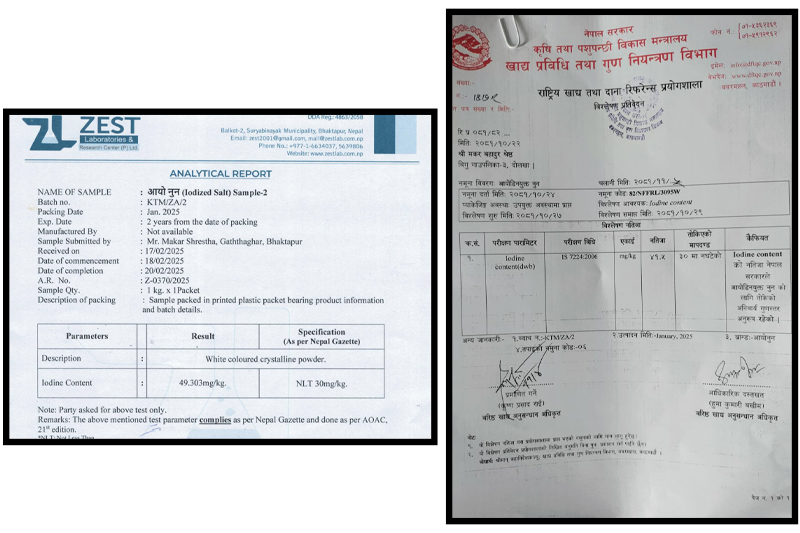
"Even if it's the same batch, the results can vary. When iodine is mixed into a large quantity of salt at once, some portions might have less, and some might have more," said Kumar Rajbhandari, Information Officer at Salt Trading Corporation.
He explained that since iodine is added to salt later, some portions may have less, and some may have more. "When mixing anything, it can never be 100 percent perfect," he says. "Therefore, when adding iodine to salt, it might be slightly more or slightly less."
He attributed the higher iodine content in the year-old salt compared to the newer salt to better packaging.
Health hazards
After goiter developed in Nepalis due to iodine deficiency, iodized salt was distributed to consumers' kitchens to prevent it. Endocrinologists have stated that the problem of goiter has been eliminated due to the iodine added to salt.
"Our Himalayan belt falls in an iodine-deficient area. When iodine levels were low, children suffered from growth issues and goiter. Now, the iodine level is high," says endocrinologist Dr. Ansumali Joshi. "This has also had an impact. With iodine in salt, thyroid hormone-related diseases have increased."
According to Joshi, goiter is no longer prevalent, but diseases related to both excess and deficiency of thyroid hormones are being observed. "Studies conducted on individuals with thyroid problems have shown that 50 percent had autoimmune issues, and one possible cause of this is iodine," says Dr. Joshi.
Cardiologists also suggest that the excessive iodine in salt has affected the heart. Dr. Rajendra Koju, a cardiologist at Dhulikhel Hospital, says that while salt is an essential substance for the body, excessive consumption can harm the heart.
The World Health Organization has set a standard of consuming up to 5 grams of salt per day. "Salt is an essential element for our body. Consuming too much affects the body. It causes high blood pressure and affects the heart," he says. "Moreover, iodized salt disrupts the thyroxine hormone. If thyroid hormone is disrupted, it also affects the heart. The impact on the heart becomes visible if thyroid hormone is not kept in balance."
Tests and errors
According to a study report published two years ago in the Annals of the New York Academy of Sciences by the New York Academy of Sciences, testing of salt samples collected from 2,117 households in seven districts of Nepal revealed high iodine levels.
The research disclosed that salt collected from over a thousand households contained more iodine than required. The study, which tested samples from 2,117 households in Dhankuta, Siraha, Kailali, Rupandehi, Kathmandu, Kaski and Chitwan, found excessive iodine in 1,777 samples.
Similarly, researchers from the Kathmandu Institute of Applied Sciences (KIAS) and the Central Department of Chemistry at Tribhuvan University found that kitchen salt contained 54 PPM of iodine.
"We tested the iodine content in salt collected directly from kitchens. The results showed that 98.8 percent of people were consuming iodized salt, with an average of 54 PPM found in iodized salt," says Basant Giri, Head of KIAS, who was involved in the study. "The WHO states that it should be 15 PPM when added to vegetables. However, our study found salt with higher iodine content."
He claims that there might have been errors during the iodine mixing process in India. He stated that salt packaged in Nepal is also brought from India after iodine is added there. The iodine content is determined when it is mixed in India. Some packaging is done in India, and some in Nepal. Iodine can evaporate during packaging and storage. It also evaporates during cooking.
He suggests that the process might be designed with the assumption that if 60 PPM of iodine is added to salt, it will be 15 PPM by the time it is cooked. NIMJN found the highest iodine level, 52.2 PPM, in salt with batch number SRC-09, packaged in India, collected from Dhangadhi in the Sudurpashchim Province. A salt sample packaged in India, collected from Birgunj, showed 32.7 PPM.
“Currently, packaging is also good. Transportation is convenient, so it reaches places quickly. Perhaps because people also store it in containers at home, we found the same amount of iodine in kitchens as was added in India," said Giri. He also mentioned that during discussions at the government level after their study results were published, the government acknowledged the high iodine content in salt. Giri informed that he learned that all levels agreed that the policy regarding the amount of iodine added in India should be reviewed.
Giri stated that while it was known that iodine deficiency in salt causes goiter and other problems, the problem arose because no one assessed what happens when there's an excess. "Studies have shown that excessive iodine in salt also affects health. Therefore, a maximum limit must now be set," Giri said.
Dr. Lal, Chief of the Family Welfare Division of the Department of Health Services, also acknowledged that suggestions are being made to review the standard of 50 PPM at the production level and a minimum of 30 PPM for retail consumers. "The standard issued by the Ministry of Agriculture is still the same," said Dr. Lal, Chief of the Family Welfare Division. "Health workers are complaining that the iodine level is too high and needs to be reduced."
Unheeded advice
Health workers and doctors have been advising the government to reduce iodine levels, citing health problems caused by iodine levels higher than those set by the World Health Organization.
A 2016 micronutrient survey conducted by the Ministry of Health and Population and UNICEF revealed high iodine levels in school-aged children.
Dr. Lal, Chief of the Family Welfare Division of the Ministry of Health, stated that studies have shown the presence of iodine in the urine of children aged 6 to 9 years. "While the required level is 100 micrograms of iodine per liter, 314 micrograms were found in the urine of school-going children," he said. "This indicates that children have high iodine levels." He stated that this confirms the high iodine content in salt.
In a study conducted five years ago on 1,000 people with hypothyroidism by Dr. Anshumali Joshi, Dr. Priyadarshini Yonjan, and nurse Sabina Tamang, 50 percent people were found to have autoimmune thyroiditis (Hashimoto's thyroiditis).
"More than 50 percent of those with thyroid problems were found to have autoimmune issues. One cause of this type of thyroid problem is high iodine levels," Dr. Lal said.
Government needs to act
Salt Trading Corporation has acknowledged that, in adherence to the government standard of 30 PPM of iodine in salt when it reaches kitchens, they add 60 PPM of iodine during packaging. "We bring salt from Gujarat, India. To fulfill the government-specified iodine level, it is mixed with water there to achieve 60 PPM and sprayed, so the iodine level in the salt can fluctuate,” said Kumar Rajbhandari
Rajbhandari also admits that there have been numerous discussions about reducing iodine levels, but they have not been implemented. "Because we lack research on food habits, the government might be continuing to implement the old standard, believing that the current situation is satisfactory," he said.
Rajbhandari clarified that Salt Trading cannot do anything until the government gives clear instructions to reduce the iodine level.
He claimed that studies have shown that 30 to 70 percent of iodine can evaporate during cooking, especially if salt is added before cooking and tomatoes are added after the salt.
How much salt do you need?
Iodized salt is the sole source of sodium chloride and iodine required by humans. If these two are not consumed daily, human health is at risk, leading to goiter and other non-communicable diseases.
Each day, 5 grams or 135-145 milliequivalents per liter of salt should be consumed. If this amount is not consumed, doctors say that the body will weaken, dizziness, nausea, fainting, and epilepsy problems will occur.
Consuming iodized salt helps prevent goiter and disability, thus aiding in the development of mental and intellectual capacity.
Dr. Lal, Chief of the Family Welfare Division, stated that iodine is also necessary to prevent physical and mental problems in the new-born babies.
Please adhere to our republishing policy if you'd like to republish this story. You can find the guidelines here.


